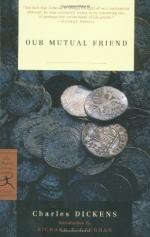|
This section contains 7,863 words (approx. 27 pages at 300 words per page) |

|
SOURCE: “Dickens's Our Mutual Friend and Henry Mayhew's London Labour and the London Poor,” in Nineteenth-Century Fiction, Vol. 20, No. 3, December, 1965, pp. 207-22.
In the following essay, Nelson studies possible sources for the characters Betty Higden and Gaffer Hexam in Our Mutual Friend from among the poor Londoners interviewed by Henry Mayhew for his nonfiction work.
Betty Higden (the character in Our Mutual Friend who would rather die than go to the poorhouse, and does) offended some of Dickens's readers, the same ones, no doubt, who felt about Jacob's Island in Oliver Twist, and the Yorkshire schools in Nicholas Nickleby, and Chancery and foreign missions in Bleak House, and the Circumlocution Office in Little Dorrit, that things were nowhere near as bad as all that, if indeed anything was really wrong at all. Dickens replied to these defenders of the Establishment as he always had: what he had embodied...
|
This section contains 7,863 words (approx. 27 pages at 300 words per page) |

|


